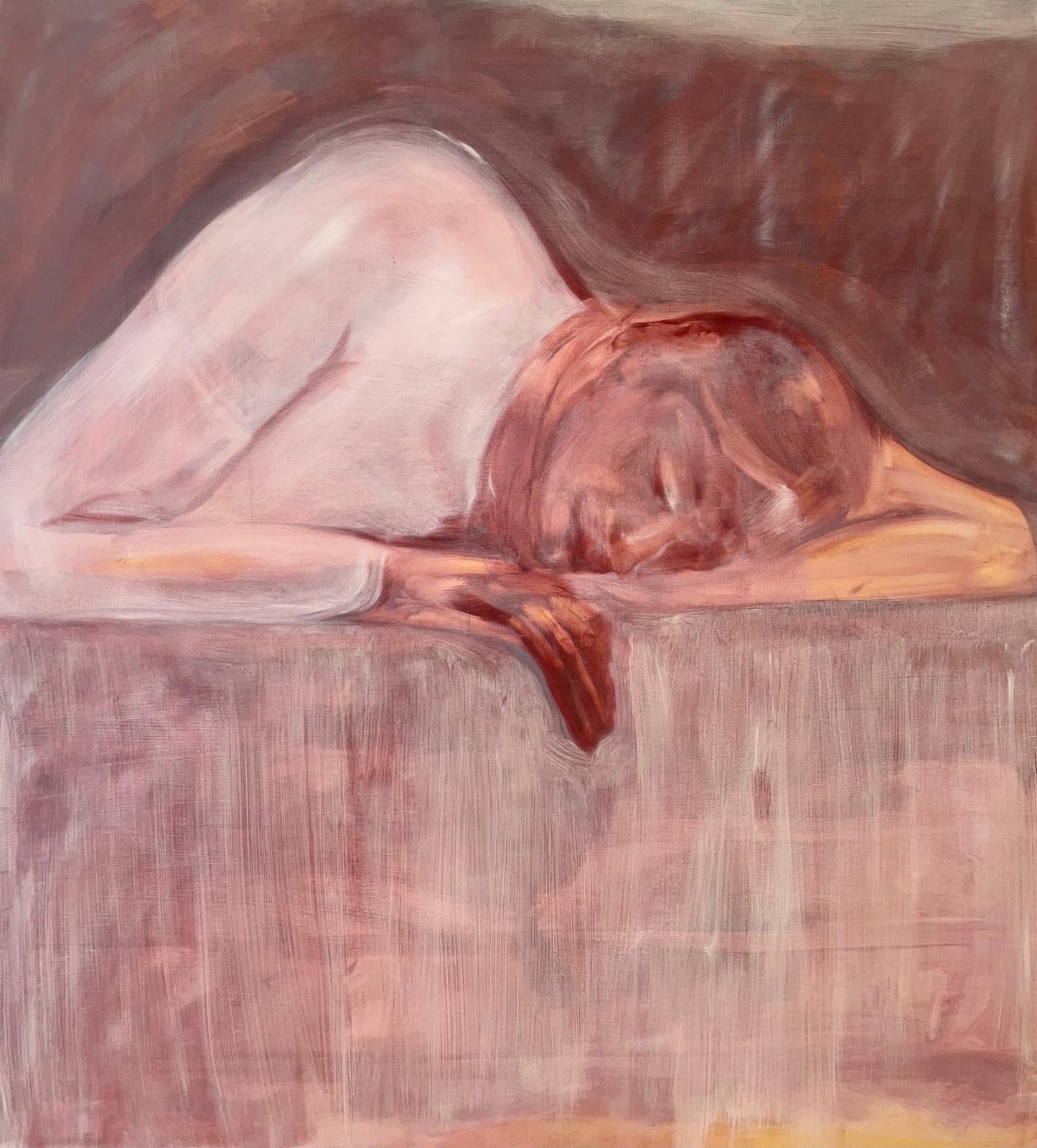Hope Turnbull British, b. 1999
On the Bed, 2023
oil on canvas
100 x 90 cm
‘On the Bed’ captures the liminal state of consciousness between waking and sleeping. Here too Turnbull focuses mainly on gesture: the clasping of the hands, the weight of the head,...
‘On the Bed’ captures the liminal state of consciousness between waking and sleeping. Here too Turnbull focuses mainly on gesture: the clasping of the hands, the weight of the head, the stretch of the shoulders. The artist does not reference the dream itself, but rather the body in that specific physical condition. Turnbull creates a synergy between person and space, as though one could not exist without the other; a state of flux, where the subject merges with its surroundings.
Paint itself is used as a tool to emphasise this idea. “Paint is a paradox of materials, it has a duality in its ability to conceal and reveal. I use thin washes of colour layered on top of one another. This creates a lightness, and the white ground beneath shines through, giving a weightless quality to the image. I balance depiction and abstraction. I must resist reality but also refer to it, for the figure in the image is to exist but not to exist.” (Hope Turnbull)
Hope Turnbull’s large-scale oil paintings depict mundane experiences, drawn and filtered through the memory of emotion to create psychologically charged domestic spaces. On the one hand, these works reference the history of representational painting, taking inspiration from artists such as Edward Hopper, Johannes Vermeer, and Mary Cassat. On the other hand, Turnbull desublimates traditional portraiture by rejecting its standard ‘pompous’ quality and representing figures that enact the routines of daily life: ironing, washing, sitting and thinking or watching television.
In doing so, Turnbull’s aim is to reference the liminal space of pre-consciousness, involving the viewer in a feeling of reverie that, while coming from a personal space for the artist, is recognisable by most. “I want the viewer to enter the space without barriers. As such, I use the home as grounding; when we see a bed, we think of sleeping, and when we see a dining table, we think of eating. I hope this allows a viewer to become immersed in the work and see themselves as the figure in their own space. My personal moments can be transformed and translated into their own image.” (Hope Turnbull)
Paint itself is used as a tool to emphasise this idea. “Paint is a paradox of materials, it has a duality in its ability to conceal and reveal. I use thin washes of colour layered on top of one another. This creates a lightness, and the white ground beneath shines through, giving a weightless quality to the image. I balance depiction and abstraction. I must resist reality but also refer to it, for the figure in the image is to exist but not to exist.” (Hope Turnbull)
Hope Turnbull’s large-scale oil paintings depict mundane experiences, drawn and filtered through the memory of emotion to create psychologically charged domestic spaces. On the one hand, these works reference the history of representational painting, taking inspiration from artists such as Edward Hopper, Johannes Vermeer, and Mary Cassat. On the other hand, Turnbull desublimates traditional portraiture by rejecting its standard ‘pompous’ quality and representing figures that enact the routines of daily life: ironing, washing, sitting and thinking or watching television.
In doing so, Turnbull’s aim is to reference the liminal space of pre-consciousness, involving the viewer in a feeling of reverie that, while coming from a personal space for the artist, is recognisable by most. “I want the viewer to enter the space without barriers. As such, I use the home as grounding; when we see a bed, we think of sleeping, and when we see a dining table, we think of eating. I hope this allows a viewer to become immersed in the work and see themselves as the figure in their own space. My personal moments can be transformed and translated into their own image.” (Hope Turnbull)
